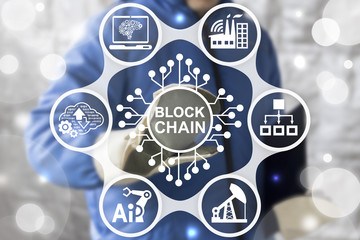Blockchain had been one of the best technologies that are bringing in significant changes with respect to data management in the world. While you may not have the correct roadmap about how to learn Blockchain, this guide will take you through some relevant details regarding the same.
What is Blockchain Technology?
Basically, Blockchain is known to be a digital ledger which can help in data storage. Here, you can enter the date, verify it and process it further, getting the approval of computer nodes over a peer-to-peer network. You may do anything from entering new data to validating or deleting the pre-existing ones. On P2P networks each transaction should be validated by a predetermined number of nodes.
The data is stored digitally into blocks that are further linked together, forming a Blockchain. For the creation of Blockchain, you may be required to create a node first, for creating a block. All the transactions are then entered within the block. The new block is then added to the existing Blockchain and broadcasted to other nodes that are on the network. Other nodes should verify the validity of transactions taking place before it is actually accepted to become a part of the Blockchain.
Apart from providing storage for data in different forms, every block also consists of a timestamp, with details regarding its generation and other data regarding classification. This helps to make sure that the chain has easier ways to sort data. It is known to be one of the ways by which automation is promoted by Blockchain technology and decentralized nature for it is maintained.
The extraordinary abilities offered by Blockchain allows the users to access their transactions along with considering the fact that all the data stored within the Blockchain is immutable and secure. If a transaction does not match up with the expectation of the chain, either at the beginning or later, it is deleted automatically and replaced with a verified version of the data that wad found corrupt.
In addition to this, if any block is entered with false data, it would get easily detected. This is because 51 per cent of the nodes that are currently active are said to sign off based on logical legitimacy before it gets permanently accepted into the Blockchain. While the Blockchain technology is regarded to be tamper-proof (virtually) with various security protocols, it isn’t the case every time. There are well-known ways to crack its security successfully.
Let’s move into knowing the process of becoming a Blockchain programmer. Blockchain programming isn’t a piece of cake that can be taken of so easily, there are many more aspects that need to be considered. You will have to work harder to become perfect with other prevailing technologies.
Most Significant Programming Languages for Blockchain Development
When you move further towards answers for how to learn Blockchain development, there are several programming languages that you will have to master. You will have to deal with codes and compilations in order to get successfully implemented Blockchains. Here are the most important programming languages that you need to learn:
-
C++
C++ is probably the oldest among all programming languages we’re going to discuss here. C++ was a process-oriented alternative brought up for the rudimentary C language. Being based on Object-Oriented Programming, C++ codes can be used again on other platforms without requiring any fresh coding.
This language retains the security, efficiency, and flexibility that were availed with C. Because of the evergreen nature it possesses, it’s considered as a core language for Blockchain coding along with Bitcoin Blockchain. This language, however, has a fairly steep learning curve with outdated syntax and a type-only platform. Moreover, the efforts you put into learning this language would be paid off as most of the Blockchain programs are written in this language.
-
Python
For beginners who may be afraid of the complexities with C++, Python could be a simple coding language to learn for Blockchain development. The structure of this language is said to be based on some simple aspects: readability, simplicity and minimalism. Because of its simplicity, this language is preferred by both beginners and experts. Instead of keywords and curly brackets that represent code blocks in C++, Python uses white spaces that are less scary and easy.
Although there are cases where simplicity could be expected to bring in inefficiency, Python has performed well to provide with reliable and stable, digital ledgers. The best thing is that it’s scripted and can be uncompiled and compiled accordingly. For instance, bugs in your codes can be fixed and it can be updated easily.
In the case of other languages including C++, you would be required to stop the application to fix bugs and then recompile the same before you restart the application. When you choose to work with Python, you save up much of work. The vast and free resource centre would help the developers with the best codes for Blockchain.
-
JavaScript
This is one of the most commonly used languages across the Web. When you desire a website that is highly interactive and consists of beautiful UIs, this language is highly preferable. It is supported by all major browsers including Firefox and Google Chrome. We already know that Blockchain consists of blocks arranged one after the other.
There is, however, something special regarding this ledger, it is said to be immutable which means once the data is entered no changes could be made to it. When you want to make simple yet tamperproof Blockchains, this is a language you can rely upon. There is only one setback to this language that it lacks SHA256 hash function.
-
Solidity
It is known to be a highly complex language that is said to apply to functions and scripts of JavaScript and C++ classes. It is, however, a beginner-friendly language that also offers instructions and tips for using its codes. While this language isn’t too complicated, the users who have a good grasp on programming are likely to be advantaged by this.
Although Solidity has been working upon establishing itself perfectly in the world of coding, Ethereum which is known to be the second most important cryptocurrency is said to be using it already. The fact that they are the creators of the language makes it sensible altogether. When considering the speed and easy creation of smart contracts, Ethreum Blockchain is considered to be the most efficient.
Therefore, during the creation of a decentralized app, build immutable, secure, multipurpose blockchain or holding initial coin offering, Solidity is a preferable application for the same. Anyone who seeks integration of smart contracts within digital ledgers should know this language.
-
GO
GO is the abbreviation for GOLang which is quite a new coding language, known to be developed in the year 2007. It was officially released in the year 2012 for public use. It is multipurpose and a robust coding language that was introduced with a view to combining both user-friendliness and syntax for other coding languages including JavaScript, keeping up various security aspects offered by languages like C and C++. GO runs inherently within an operating system that brings in maximum flexibility especially while dealing with Blockchain. The SDK protocol for Ethereum is known to be written using GO.
How can you become a Blockchain Developer?
Blockchain is although a single team, there are various parts on which developers carry on their work. No one stops you from acquiring knowledge about everything that is to be considered with respect to a digital ledger. However, it would be rather suitable to focus on smaller branches and master them before moving further to the others. The core elements of Blockchain that need to be developed include:
- Smart Contracts
- Decentralized Applications (Daaps)
- ICOs
There are still some things before you roll up your sleeves. Most of the well-skilled programmers tend to search through plenty of resources before they get started with anything. Therefore, once you get to know your preferred language, read Bitcoin’s white paper, suitable blogs and also check out several books that dive deeper into the languages you’re learning.
Read More:-TOP 16 BLOCKCHAIN DEVELOPMENT TOOL FOR BEGINNER’S
Getting to know your industry more will never bring in any losses. If you desire to go deeper into the world of Blockchain, you will have to get some cryptocurrencies and use them around. This will let you know how the platform works practically. There are several courses that would provide you with in-depth knowledge of the languages and understand Blockchain development in a better way. This way, beginners would have easier coding experiences.
Summing Up
While the demand for Blockchain development is growing with its probable emphasis within the industry, there are many resources that let you attain the best learning experiences for the same. Start with mastering a few common Blockchain programming languages and grabbing deeper knowledge about it. This guide regarding how to learn Blockchain development will let you proceed perfectly towards your goals. Learning Blockchain programming could certainly bring you appreciable opportunities for boosting your career growth.


